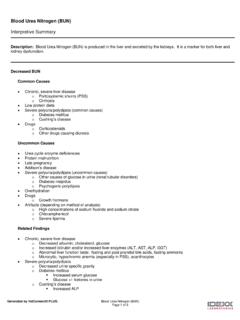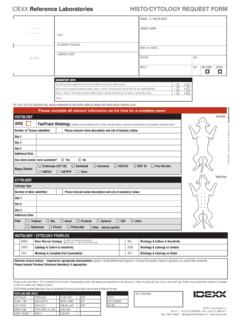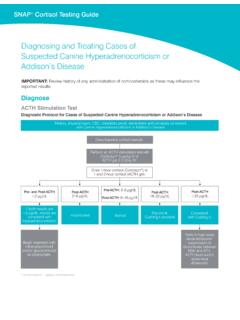Transcription of fax e-mail: DEXAMETHASONE SUPPRESSION TEST (LOW …
1 Page 1 of 2 UK-LCS-PRO-12 DEXAMETHASONE SUPPRESSION Test (Low Dose) Canine Low Dose DEXAMETHASONE SUPPRESSION Test Indications Diagnostic test for the differentiation of normal dogs from those with hyperadrenocorticism ( cushing s disease ). Note a) In most situations low dose DEXAMETHASONE SUPPRESSION testing (LDDS) is regarded as the test of choice for diagnosis of hyperadrenocorticism in the dog. Reported sensitivities for LDDS for diagnosis of hyperadrenocorticism range from 90-95%, suggesting LDDS to be a more sensitive test than ACTH stimulation testing.
2 However, 5-10% of cases will be negative when first evaluated and will require retesting after a few months. Specificity of LDDS is poor (51%) in dogs with non adrenal disease and concurrent illness (particularly diabetes mellitus and renal failure.) Positive test results should always be interpreted in light of history and clinical signs b) Determination of whether animals with diabetes mellitus have concurrent hyperadrenocorticism may be difficult. In such cases both the ACTH stimulation test as well as the low dose DEXAMETHASONE SUPPRESSION test have been reported to produce false positive results.
3 In most instances a combination of both tests in addition to an ultrasonographic examination of the adrenal glands are necessary for complete diagnostic evaluation. Please contact the laboratory to discuss the approach to such cases c) LDDS testing cannot be used for diagnosis of hypoadrenocorticism (Addison s disease ). ACTH stimulation testing is the only test that can be used to make this diagnosis. d) LDDS testing cannot be used for monitoring patients receiving trilostane (Vetoryl). Only ACTH stimulation testing, 4-hour post trilostane basal cortisol concentrations, or pre- and 4-hour post trilostane basal cortisol concentrations can be used to monitor patients receiving treatment with trilostane.
4 E) Where there has been administration of oral, injectable, or topical steroids, LDDS testing should be delayed for at least 2-4 weeks after the withdrawal of therapy to allow normalisation of the pituitary-adrenal axis. Longer withdrawal times may be needed for long acting steroids, even when used topically IDEXX Laboratories Ltd Grange House, Sandbeck Way Wetherby West Yorkshire LS22 7DN tel: UK: +44 (0)20 378 87508 Eire:+353(0) 156 21211 fax: +44 (0)1937 544001 e-mail: DEXAMETHASONE SUPPRESSION TEST (LOW DOSE) (LOW DOSE) Page 2 of 2 UK-LCS-PRO-12 DEXAMETHASONE SUPPRESSION Test (Low Dose) f) Prior administration of delmadinone (Tardak) and progestagens such as proligestone (Delvosteron) may also significantly affect LDDS test results for variable periods of time.
5 Please contact the laboratory for further advice on testing these cases. Protocol Volumes of DEXAMETHASONE use for intravenous injection to perform LDDS testing are small. In some cases, especially in small dogs, it can be helpful to dilute the DEXAMETHASONE in saline or sterile water for injection before administration. 1) Collect 1-2 mL blood in plain/gel tube. Serum should be spun and separated and labelled with the name of the patient and the time of the sample. 2) Inject DEXAMETHASONE ( mg/kg) intravenously.
6 3) Collect second blood sample 4 hours post injection of DEXAMETHASONE . 4) Collect third blood sample 8 hours post injection of DEXAMETHASONE . 5) All samples should be spun and separated and labelled with the name of the patient and the time of the sample. 6) Submit separated serum samples and request form to the laboratory. Please include a history, including drug history and select the appropriate test code (DEXL) to allow interpretation of the result. Patterns of results on LDDS Testing Basal cortisol Cortisol 4 hours post DEXAMETHASONE Cortisol 8 hours post DEXAMETHASONE Interpretation Any Any <40 nmol/L Negative for hyperadrenocortiscm Normal <50% of basal or <40 nmol/L >40 nmol/L Pituitary dependent hyper- adrenocorticism (false positives with stress or concurrent disease ) Normal >50% basal or >40 nmol/L >40 nmol/L but <50% of basal Pituitary or adrenal dependent hyperadrenocorticism







